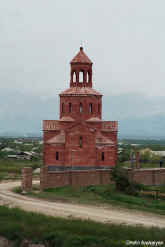|
UNDER
CONSTRUCTION
|
A
left fork from the middle of
Verin Artashat leads to Hnaberd
(till
1949 Kurbantepe or Toprakkale), the closest village to the low
brown hill of decomposed mudbrick marking the citadel
of Dvin ("dvin" means "hill" in Middle
Persian), founded in
the 4th c. AC by King Khosrov III and for
centuries the capital and
the largest |
|
Continuing
straight from
Verin Artashat one reachs
the village of Dvin
(till 1950 Dyugun Hay). |

|
|
and
richest city of Armenia.
At its peak, Dvin's population may have surpassed
100,000, with Armenians, Jews, Arabs, Kurds, and others living
together in reasonable harmony under a Muslim governor appointed
by the Caliph in Baghdad.
The Arab geographers reported that Dvin (called Dabil in
Arabic) exported a wide range of wool and silk textiles,
"Armenian wares" of a quality famous throughout the
Muslim world, some elaborately figured and dyed with cochineal.
Excavations at Dvin from the 1940s through 1970s revealed
metal-working, glass-blowing, other luxury goods, and gorgeous
glazed pottery, as well as coins from a mint that functioned at
least until AD 930.
The city was walled, with multiple gates labeled for the
roads they served:
to Ani, Tbilisi, Nakhichevan and beyond. Turning R on a
paved road before the modern village of Dvin, pass S through the
village, and enter the site on the left through the gate in a
metal fence.
First monument is the massive foundation of a major 5th
c. basilica, dedicated to S. Gregory the Illuminator, with a
smaller, centrally planned church built inside it when the
basilica collapsed in one of Dvin's many earthquakes.
Beyond are remains of the small S. Sargis church and a
palace (excellent column capitals), presumably the remains of
the palace of the Katholikos.
From the testimony of the 10th c. Arab
geographer Ibn Hawqal, this palace became the cathedral mosque
of the city. Following a path right, one crosses a small green
gully with cows to reach the old excavation quarters, now the
storage area for worked stone blocks and the site of a small
museum with
excellent Persian-style glazed ceramic bowls from Dvinís
medieval period.
Left above the museum, a path leads up to the citadel.
One km S of the citadel the archaeologists found remains
of a large 5th c. market building.
|
|
|